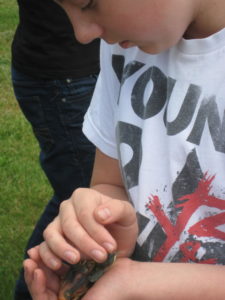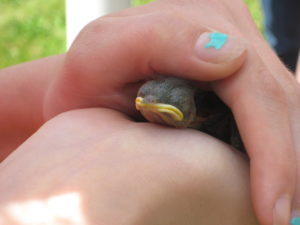https://www.youtube.com/watch?v=L1QTqAE51PI
For the past few years during our winter months, I have observed Eastern Bluebirds on our campus. Often small flocks (3 to 4 birds) of these beautiful blue backed, chestnut chested creatures have been seen perched on the Quaker banners behind the Hanshi building and on the metal fence west of Teacher Megan’s Pre-K classroom. The idea popped up to place bluebird boxes around the campus to encourage these magnificent songbirds to nest and raise their family here.
 Well, that idea has now blossomed into a bluebird trail and a pair of bluebirds currently raising a family right before our eyes. With the help of Teacher Jim and local resident Dave Gilcrest (member of the National Bluebird Society), the 7th grade constructed six bluebird boxes/stands (one was sold at the auction) and erected them in five very specific locations to attract bluebirds. While the nest box by the wooden pergola is occupied by bluebirds, the other nest boxes currently have nests from a pair of Carolina Chickadees and a pair of House Wrens. House Sparrows (an invasive non-native species) have attempted nest building in two of the other boxes. To discourage these sparrows we have already removed their nesting material numerous times this spring. Once a week, the 7th grade visits their assigned boxes to monitor and record any observations. This citizen science project has our students recording info which will be imputed into a national database.
Well, that idea has now blossomed into a bluebird trail and a pair of bluebirds currently raising a family right before our eyes. With the help of Teacher Jim and local resident Dave Gilcrest (member of the National Bluebird Society), the 7th grade constructed six bluebird boxes/stands (one was sold at the auction) and erected them in five very specific locations to attract bluebirds. While the nest box by the wooden pergola is occupied by bluebirds, the other nest boxes currently have nests from a pair of Carolina Chickadees and a pair of House Wrens. House Sparrows (an invasive non-native species) have attempted nest building in two of the other boxes. To discourage these sparrows we have already removed their nesting material numerous times this spring. Once a week, the 7th grade visits their assigned boxes to monitor and record any observations. This citizen science project has our students recording info which will be imputed into a national database.
 Why bluebirds? Over the years, land has been cleared for housing and industrial developments, malls, highways and cropland; many old trees have been cut down for firewood. Wooden fence posts that provided nesting cavities have now been replaced with metal posts. This modernization has reduced the number of natural nesting cavities causing a reduction in the numbers of nesting cavity species. Compounding the problem of habitat loss has been the introduction into North Am. two imported species – the House Sparrow and the European Starling. Both starlings and sparrows are cavity nesters, and are both very aggressive. House Sparrows are small enough to enter any hole that a bluebird can, and are so aggressive that they will chase away the more timid bluebirds. Starlings can be excluded from bluebird boxes by using the correct size entrance hole, but will out-compete bluebirds for woodpecker holes and other natural nesting cavities. During the summer, bluebirds feed mainly on insects. In the winter, bluebirds depend on many kinds of wild berries for their food supply. However, the supply of wild berries has also decreased over the years. The few berries that remain are often stripped quickly by large flocks of starlings.
Why bluebirds? Over the years, land has been cleared for housing and industrial developments, malls, highways and cropland; many old trees have been cut down for firewood. Wooden fence posts that provided nesting cavities have now been replaced with metal posts. This modernization has reduced the number of natural nesting cavities causing a reduction in the numbers of nesting cavity species. Compounding the problem of habitat loss has been the introduction into North Am. two imported species – the House Sparrow and the European Starling. Both starlings and sparrows are cavity nesters, and are both very aggressive. House Sparrows are small enough to enter any hole that a bluebird can, and are so aggressive that they will chase away the more timid bluebirds. Starlings can be excluded from bluebird boxes by using the correct size entrance hole, but will out-compete bluebirds for woodpecker holes and other natural nesting cavities. During the summer, bluebirds feed mainly on insects. In the winter, bluebirds depend on many kinds of wild berries for their food supply. However, the supply of wild berries has also decreased over the years. The few berries that remain are often stripped quickly by large flocks of starlings.
 If you want to observe the bluebirds, you can sit quietly under the wooden pergola (by the soccer field). The bluebird pair can be seen perching on the corner of the pergola, on the fence in front of the nest box, and on top of the box itself. A pair of binoculars really helps and gives you a spectacular view of these beautiful creatures. Currently there are five nestlings that just hatched this week (April 22 -24). We will soon be putting small, lightweight aluminum bands on their legs to keep track of their travels once they leave the box. During the next two weeks, the male and females will be feeding the young ones and guarding the nest box from other aggressive cavity nesters. Once they leave the nest box we will remove all the nesting materials so the pair can begin a new nest building cycle.
If you want to observe the bluebirds, you can sit quietly under the wooden pergola (by the soccer field). The bluebird pair can be seen perching on the corner of the pergola, on the fence in front of the nest box, and on top of the box itself. A pair of binoculars really helps and gives you a spectacular view of these beautiful creatures. Currently there are five nestlings that just hatched this week (April 22 -24). We will soon be putting small, lightweight aluminum bands on their legs to keep track of their travels once they leave the box. During the next two weeks, the male and females will be feeding the young ones and guarding the nest box from other aggressive cavity nesters. Once they leave the nest box we will remove all the nesting materials so the pair can begin a new nest building cycle.
So this is really exciting for our school and for our students to have bluebirds nesting right by our soccer field. It is also exciting to have our students participating in this country wide citizen science project gathering valuable information about this endangered yet beloved bird. Recently, the NJ Bluebird Society returned to put bands on three of the hatchlings with the assistance of the 7th Graders. We are making a difference even if it is one bird at a time!
This blog post was written by Teacher Peter Manzelmann, FSMH’s on campus naturalist and nature instructor.



Follow and Contact Us